For many in India, the combination of chai (tea) and paratha is more than just breakfast; it’s a cultural staple. The warm, comforting sip of tea paired with a crispy, golden paratha evokes nostalgia and tradition. This duo is enjoyed across households, roadside dhabas, and bustling city cafes, making it an inseparable part of Indian mornings.
However, while it may satisfy taste buds and provide a quick energy boost, it may not be the healthiest way to start your day. The combination of fried bread and tea with sugar and milk might do more harm than good, affecting digestion, metabolism, and overall well-being. Many nutritionists and health experts suggest that consuming chai and paratha together can lead to long-term health issues if made a daily habit.
So, what makes chai paratha an unhealthy breakfast choice? Let’s explore the reasons why this pairing might not be ideal and discover some healthier alternatives for a more balanced start to the day.
The Problem with Chai Paratha
1. High in Unhealthy Fats and Carbs
Parathas are often made using refined flour (maida) or whole wheat flour and are generously fried in ghee or oil. This makes them high in carbohydrates and unhealthy fats, which can contribute to weight gain and heart-related issues when consumed frequently.
2. Chai’s Hidden Pitfalls
Chai is typically prepared with full-fat milk and sugar, adding unnecessary calories to your meal. Excessive sugar intake can lead to insulin resistance, obesity, and other metabolic disorders over time. Moreover, the caffeine in chai can disrupt the acid-base balance in the stomach, leading to acidity and bloating. The presence of theophylline in tea can weaken the lower esophageal sphincter (LES), contributing to acid reflux or GERD.
3. Lack of Nutritional Balance
While paratha provides energy, it lacks essential nutrients like fiber, protein, vitamins, and minerals. A breakfast should ideally include a balance of macronutrients—proteins, healthy fats, and fiber—to keep you full and provide sustained energy throughout the day. Additionally, tea contains tannins, which can reduce protein absorption by up to 38%, further decreasing the meal’s nutritional value.
4. Digestive Issues
Parathas are heavy and take time to digest, while tea contains tannins and phenolic compounds that can interfere with iron absorption. This can lead to anemia-related symptoms such as nausea and vomiting, especially for individuals already low in iron. The combination of high-fat parathas and caffeine can also lead to indigestion, bloating, and acid reflux, making it difficult to start your day on a good note.
5. Energy Spikes and Crashes
A breakfast high in refined carbs and sugars can cause a rapid spike in blood sugar, followed by a crash that leaves you feeling tired and lethargic. A more balanced meal with complex carbs, protein, and fiber would provide steady energy levels.
How to Reduce GERD and Improve Digestion
If you experience acid reflux or digestive discomfort, consider the following:
- Consume tea at least 45 minutes after meals instead of with food.
- Switch to green tea or ginger tea, which contain lower caffeine levels and support gut health.
- Eat smaller, more frequent meals to prevent overloading the digestive system.
- Stay hydrated and drink alkaline water to reduce stomach acidity.
- Avoid slouching while eating and wait at least 30 minutes before lying down after meals.
- Opt for steaming, boiling, or poaching food instead of deep-frying.
Healthier Breakfast Alternatives
Instead of chai and paratha, consider these delicious and nutritious options:

- Vegetable Upma with Sprouts – A light and fiber-rich breakfast with added protein from sprouts.
- Masala Oats with Yogurt – A heart-healthy option loaded with fiber and probiotics.
- Poha with Green Tea – A flavorful, light dish paired with antioxidant-rich tea.
- Moong Dal Chilla with Mint Chutney – A protein-packed alternative to parathas.
- Idli with Sambhar and Coconut Chutney – A balanced meal with fiber, protein, and probiotics.
- Millet Dosa with Avocado Chutney – A gluten-free, nutrient-rich alternative.
- Muesli with Fresh Fruits and Yogurt – A quick, wholesome breakfast packed with vitamins and minerals.
- Quinoa Khichdi with Roasted Papad – A protein-rich twist on traditional khichdi.
For more healthy Recipes check out our food recipes blogs
While chai and paratha are undeniably tasty and comforting, they may not be the best combination for a healthy start to the day. Instead, opting for balanced, nutrient-dense meals can enhance energy levels, improve digestion, and support overall well-being. Making small changes in your breakfast habits can have a significant impact on your long-term health.
Would you still choose chai paratha, or are you open to trying a healthier alternative? Let us know in the comments!

